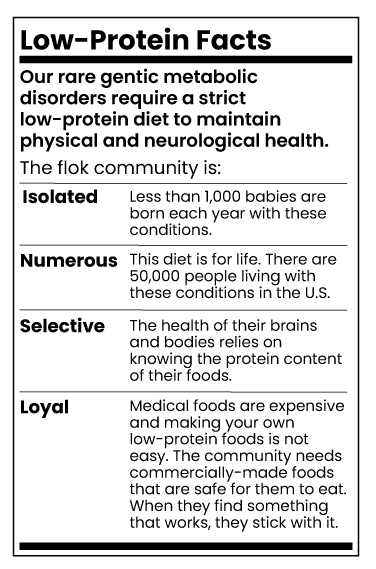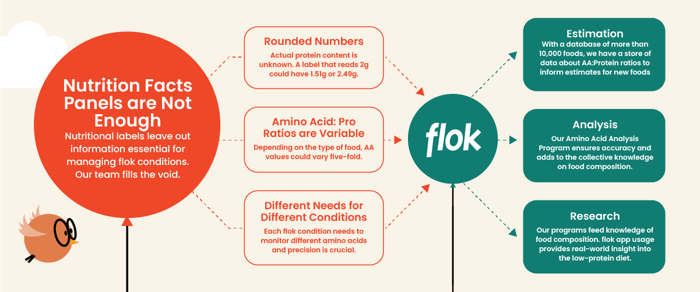Food as Healthcare
 The common thread that ties together the conditions served by flok is the medical necessity of a low-protein diet, including medical food and formula, due to a deficiency in amino acid metabolism. For PKU, this treatment was discovered and implemented in the 1950s. The advent of Newborn Screening in the 1960s meant it could be initiated shortly after birth, transforming the positive outcomes for individuals with these disorders. Even as more treatment options develop, adherence to a low-protein diet remains crucial to healthy neurological and organ system function throughout the flok. Whether it’s leucine, lysine, methionine, phenylalanine, valine, isoleucine, or whole protein, precise, accurate, and dynamic nutritional information is essential for thriving with these conditions. For 35 years, PKU News ensured that this data was accessible to those who needed it, primarily focused on those with PKU. As flok, our responsibilities have expanded to serve those with additional disorders as well. This article explores the changing landscape, our approach to its challenges, and how our work advances nutrition science for the entire community.
The common thread that ties together the conditions served by flok is the medical necessity of a low-protein diet, including medical food and formula, due to a deficiency in amino acid metabolism. For PKU, this treatment was discovered and implemented in the 1950s. The advent of Newborn Screening in the 1960s meant it could be initiated shortly after birth, transforming the positive outcomes for individuals with these disorders. Even as more treatment options develop, adherence to a low-protein diet remains crucial to healthy neurological and organ system function throughout the flok. Whether it’s leucine, lysine, methionine, phenylalanine, valine, isoleucine, or whole protein, precise, accurate, and dynamic nutritional information is essential for thriving with these conditions. For 35 years, PKU News ensured that this data was accessible to those who needed it, primarily focused on those with PKU. As flok, our responsibilities have expanded to serve those with additional disorders as well. This article explores the changing landscape, our approach to its challenges, and how our work advances nutrition science for the entire community.
Complexity of Counting Protein
Given the rare nature of our conditions, the nutrition science and the dietary practices of our community have historically been understudied and under-supported. While the USDA was a key original source of Amino Acid Data for the Low Protein Food List for PKU, its value to our community has diminished in recent years: food labeling requirements are insufficient for our community, accuracy is unenforceable, and the agency has dramatically scaled back its food analysis programs—relying instead on manufacturer-reported data. The current practices present several challenges to our community:
- In the United States nutrition fact labels feature rounded protein values: a label that reads 2g protein per serving could have as little as 1.51g of protein, or as much as 2.49g. This difference represents 20% of the dietary intake of someone with a strict protein tolerance of 5g protein.
- Amino acid content per gram of content varies based on the type of food. For an apple, 1g protein contains 15mg phenylalanine; for wheat bread, that same 1g protein contains 50mg phenylalanine, more than 3 times as much.
- All amino acids have their own ratios to protein: Green peas, for example, contain over 16 times more leucine than phenylalanine, making them more acceptable for the PKU diet than the MSUD diet, in which leucine is the amino acid of interest.
Jenn Beazer, Registered Dietitian at flok states, “Understanding the amino acid content of foods is critical to those with inherited metabolic conditions in protein pathways. This knowledge is the power to adequately fuel our bodies with appropriate, safe, and enough food.” Jenn has nearly 20 years of experience and specializes in metabolic conditions. She reports that many individuals with an inherited disorder of protein metabolism find it difficult to feel full and satisfied after a meal. Through amino acid analysis, dietitians gain a better understanding of food composition to increase an allowable range and volume of foods. This knowledge enables our community to eat more of the foods they enjoy.
Part of Jenn’s role at flok is to respond to the community’s requests for accurate protein and amino acid content of new foods that come to market, and make sure data on existing foods is up to date. The process for doing so was developed by PKU News founder Virginia Schuett, RD, and has been refined over the last decades. To determine, for example, the phenylalanine content of a food, we’d follow these steps:
- First, we obtain (from a company or through testing) the unrounded protein in 100g of the food
- Next, we examine the top phe-containing ingredients in the product and use their phe:protein ratios to estimate the amount of phe in the product. If a product contains even small amounts of high-phe ingredients like pea protein or yeast, these are accounted for as well.
- Using these data, we determine the amount of protein and phenylalanine per serving and then compare that value to other values in the database to make sure there is consistency and no error in the assessment.
The Partnership for PKU is a key vehicle for working with brands to make sure our community has the information we need to build healthy diets. flok currently partners with over 300 food brands, educating manufacturers on the need for precise protein content, the needs of our community, and the benefits of meeting those needs. Many of these brands are featured on our menus at Family Camp – Daiya, Sheese, Follow Your Heart, and So Delicious have been particularly helpful and generous.
With flok’s expansion to serve the broader metabolic community, we’ve evolved the phenylalanine-estimation process to account for leucine, lysine, methionine, valine, and isoleucine. Wherever possible, amino acid data from USDA and the clinician database Metabolic Pro will be incorporated into flok. Where data is missing, industry-standard estimates are used to estimate those values. As part of our scientific strategy, flok will continue to refine these ratios to provide more precise data for diet management.
| Amino Acid | mg per gram of protein |
| Leu | 60 |
| Lys | 35 |
| Met | 25 |
| Phe | 50 |
| Val | 34 |
| Iso | 27 |
Amino Acid Analysis Program
In addition to our evaluation process, flok also uses a rigorous Amino Acid Analysis Program to capture accurate protein values for specific foods. Since its implementation in 2014, we have continually expanded this program to analyze foods that are:
- Suitable for a low-protein diet
- Popular within the community (food requests are made directly by our flok members)
- Widely available
- Unique or incomparable in composition to a similar product
Once a food is selected for testing, we send samples to two independent and renowned food laboratories equipped to detect small amounts of amino acids present. The scientific teams review the lab results for consistency and conduct additional tests as needed. Once the data is reviewed for accuracy, our dietitian evaluates amino acid values before publishing to the food database in the flok app. Priorities for testing are established based on two criteria: new processed foods that are popular and for which we can’t obtain unrounded protein and, foundational ingredients in processed food (e.g. flours). The values of these guide our estimation process and improve accuracy across multiple foods in the flok database.
Advancing Nutrition Science
Maintaining, updating, and expanding the food database at flok to ensure our community has the information it needs for diverse, healthy, and satisfying diets is important. Equally so are our efforts to advance the science of nutrition in metabolic disorders. One example of this is research we completed on How Much Phe users’ application of the Simplified Diet for PKU. This data, presented at the NORD summit and the 2021 GMDI Virtual Conference, and followed up by a Presentation at GMDI in 2022, highlighted the dramatic variance in the application of the practice throughout North America.
We continue to work with Genetic Metabolic Dietitians International, the National Society for Phenylketonuria in the UK and other partners to share data on amino acid content and dietary practices.
Our current programs are also designed to advance understanding of both the composition of the foods in the low-protein metabolic diet, and how the diet is experienced by those in the flok community.
- Amino acid analysis will lead to better understanding of the impact of certain foods in the diet on biomarkers
- Our expanded focus on five amino acids in additional to phenylalanine not only opens up new options to those with non-PKU disorders, but brings more research to bear on those amino acids than in the past
- Machine learning applied to our rich dataset has the potential to allow us to predict protein and amino acid content in foods. Some work has already been done in this area.
Dietary records from the flok app will help us understand what foods people are consuming and when layered with data from other sections of the app, may illuminate how those foods impact other areas of health.
With greater understanding, we can create more dietary options for our community, better understand their impact, and dramatically improve quality of life. If you or someone you love has a metabolic condition requiring a low-protein diet, the flok app provides trusted nutrient data you need to make daily food selections. Use of the app to track and record your intake will improve your quality of life and support future research as we learn more about how diet interplays with other lifestyle factors in these metabolic conditions. Your participation powers our mission as we work to make the low-protein life easier.
All food additions and updates to How Much Phe are currently on hold as we transition to the flok app as the primary nutrition management tool for our metabolic community. We will continue to collect food requests from HMP users and incorporate this data into the flok app.



